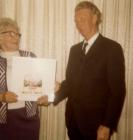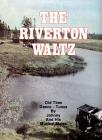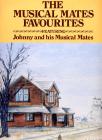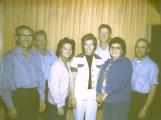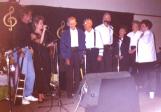111
Pictured are "Johnny and his Musical Mates" entertaining in the Hecla Hall. The orchestra would play until the early hours of the morning and never miss a beat.Harold Bjornson on guitar, Laugi Johannesson on drums, Kris Johannesson on violin and Daisy Jonasson on piano.
112
''Johnny and his Musical Mates'' Recording at the Century 21 Studio.1970
Studio in Winnipeg, Manitoba
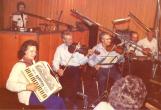
114
''The Gimil Waltz'' Johnny and his Musical Mates first recording1965
Studio in Winnipeg, Manitoba

115
Many fond memories were recalled when Johnny and his Musical Mates played "The Gimli Waltz". This tune is linked closely to New Iceland and has a history of its own. It only seemed appropriate that the orchestra would give their first recording the name of this classic composition.117
RIVERTON WALTZTRIBUTE TO RIVERTON
Immigrants from Iceland lead by the "Father of New Iceland", Sigtryggur Jonasson, arrived at Riverton in September of 1876. They made their way by flatboat and small boats from Winnipeg. On their arrival they measured out the land- 160 acres for each family. Cutting trees for logs, and the building of cabins to withstand the cold occupied the men during the first months. A school and a church were organized within a short time. They received a government loan with which they bought food supplies for the winter, stoves and the most essential household articles, some tools and 40 cows. In April of 1877, another loan was secured to buy seed, implements, nets, food, supplies and 250 head of cattle. These loans were repaid by 1889.
The settlement was first named "Lundi". The name was later changed to "Icelandic River". It divides the present village into a west side and an east side. In 1914, with the coming of the railroad, the name "Riverton" was given to the settlement. Four or five Indian families lived on the banks of the river. Among them was John Ramsay, who proved himself a great friend to the Icelanders.
The outbreak of smallpox which was thought to have come from cloth from Quebec curtailed things the first winter. Many died and many were left with throat and lung complaints. Life in the colony during this time was depressing. The lack of nursing care for the suffering, the lack of supplies, and the loss of loved ones increased the sense of isolation and loneliness. The colony was quarantined for approximately eleven months, which had a serious effect on its economy. The fish and knitted goods could not be sold outside the area, and the people could not seek employment in other parts of the province.
Regardless of all the hardship, the first newspaper in North America, "Framfari", was published and a constitution for government was drawn up. In 1877, five men were elected to administer local affairs. This led to a municipal government with a council to deal with local matters, property tax, roads and welfare.
Ukrainian pioneers settled to the west of Riverton in 1908, the Hungarians to the south in 1905 and 1908, and the Mennonites to the north in 1952.
In 1951, Riverton was incorporated into a village with a mayor, four elected councillors and a secretary-treasurer. The first mayor, S.V. Sigurdson, served until 1965.
One of the established industries of the village was the building of boats and barges by the Riverton Boat Works. These products are presently shipped all over North America.
Today the growth industry is tourism because of its proximity to Hecla Island Provincial Park which is linked to the mainland by a causeway. Riverton is the gateway to Hecla Island, Manitoba's show place and recreation spot.
In 1976, the year of Riverton's centennial, the "Riverton Waltz" recognized the contributions of its forefathers with the following dedication:
It is most fitting on the occasion of Riverton's Centennial Year of 1976 that we recall the story of our pioneers. The heritage they left and the fruits of their labour should be a challenge to each and every one of us, not to break faith with those who dared to dream, but go forth into the next century with the same faith and courage.
IN TRIBUTE TO THE PIONEERS, THIS RECORD IS DEDICATED IN RESPECT AND WITH HUMBLE THANKS FOR THEIR GREAT SACRIFICES.
Written by: Beatrice Olafson
119
This recording was a compilation of favourites by "Johnny and his Musical Mates". This album consisted of a variety of classics that were popular at dances. The music on this record would keep your toe tapping from beginning to end.123
TRIBUTE TO THE MUSICAL MATESI would like to thank everyone for coming tonight. I just can't believe what a great turn out we had.
I would like to tell you, that to commemorate the Hootenanny, we had to do a little tribute to "Johnny and his Musical Mates", who are the biggest influence in the entire community.
We can't tell you how proud we are to have such an incredibly talented group of people among us. We are so delighted that Johnny could make it tonight to accept this plaque.
The plaque is presented to "Johnny and His Musical Mates" to commemorate fifty years of music and memories. It is a little violin and a plaque.
Thank you very much, and thank you for sharing so many years of wonderful music with us.
Presenter: Brenda Fulsher
124
Johnny Johannesson holding the award received at the 30th Anniversary Hootenanny1994
Riverton, Manitoba

